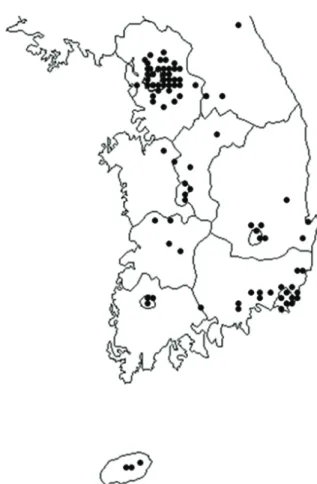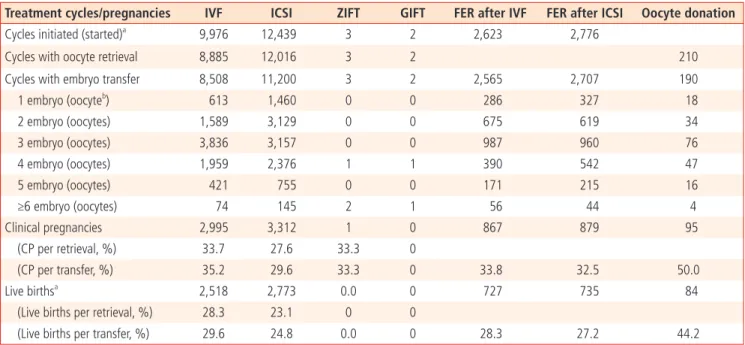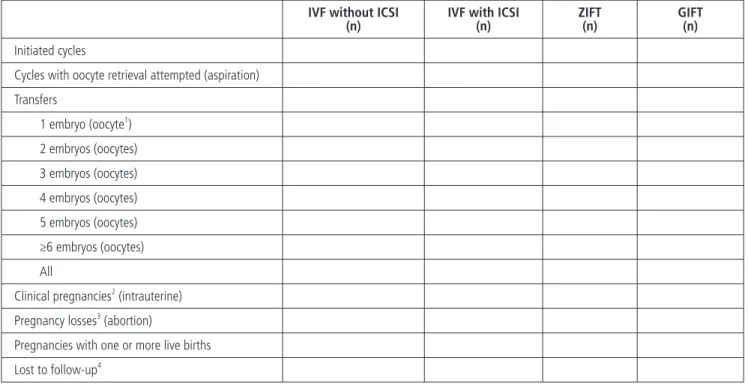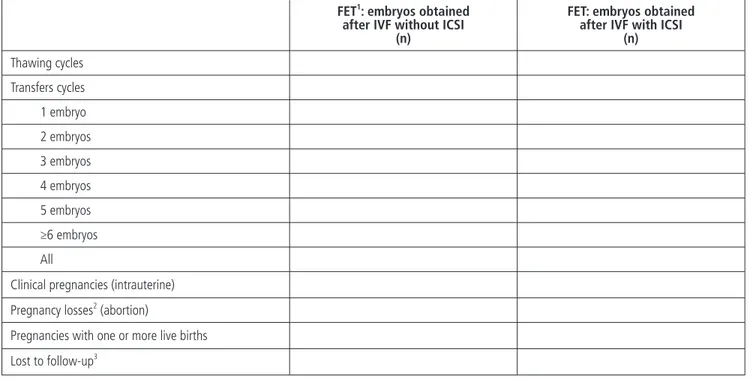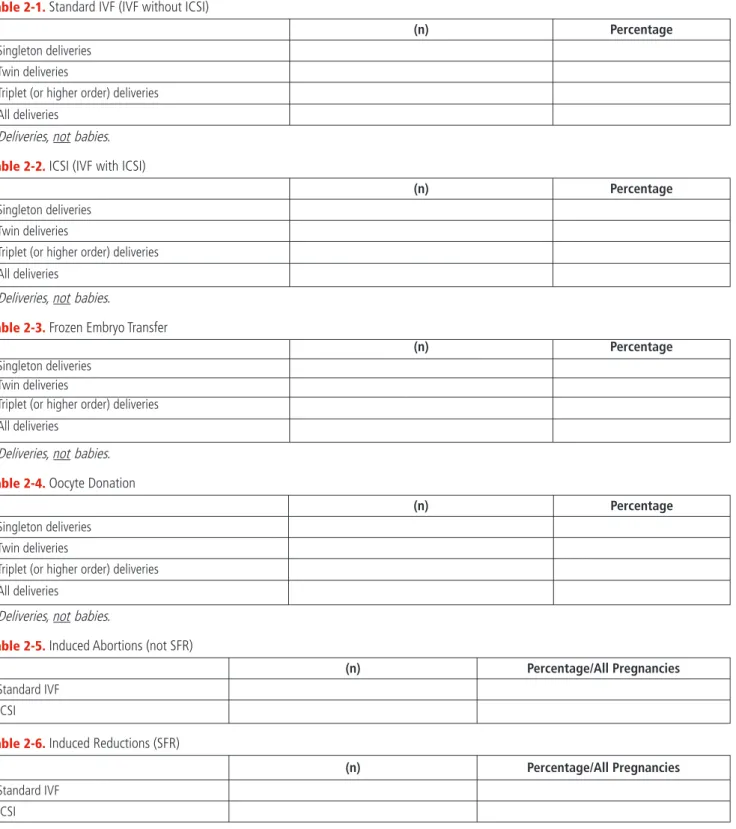CURRENT STATUS OF ASSISTED REPRODUCTIVE TECHNOLOGY IN KOREA, 2008
Assisted Reproductive Technology Committee, Korean Society of Obstetrics and Gynecology
Received: 2011. 7.30. Accepted: 2011. 8.10.
Corresponding author: Young Min Choi, MD, PhD Department of Obstetrics and Gynecology, Seoul National University College of Medicine, Yeongeon-dong, Jongno-gu, Seoul 110-744, Korea
Tel: +82-2-2072-2385 Fax: +82-2-762-3599 E-mail: ymchoi@snu.ac.kr
Th is is an Open Access article distributed under the terms of the Creative Commons Attribution Non-Commercial License (http://creativecommons.org/licenses/
by-nc/3.0/) which permits unrestricted non-commercial use, distribution, and reproduction in any medium, provided the original work is properly cited.
Copyright © 2011. Korean Society of Obstetrics and Gynecology http://dx.doi.org/10.5468/KJOG.2011.54.12.741
pISSN 2233-5188 · eISSN 2233-5196
1985년 국내에서 체외수정시술에 의한 첫 시험관아기가 탄생한 이 래 불임 환자 치료를 위한 보조생식술은 날로 그 시술 기관과 시행수가 증가되고 있을 뿐만 아니라, 치료성적도 괄목할 만큼 개선되는 등 불임 증 진단과 치료에 많은 발전이 있어 왔다. 불임을 치료하기 위해 보조 생식술을 시행하고 있는 의료기관으로부터의 자료는 성공적인 보조생 식술, 즉 생아의 출산을 가능하게 하는 여러 가지 요소들에 대한 풍부 하고 귀중한 자료가 될 수 있다. 각 의료기관별의 치료 성적은 그 자체 로도 의미가 있지만 성공률과 성공에 영향을 주는 요소에 대한 통합적 인 분석을 위해서는 국내의 여러 의료기관으로부터의 자료를 취합하여 국내 통계를 구해보는 것이 의미가 있을 것이며, 이러한 조사는 국내 불임 환자 및 보조생식술 시술 기관의 실태 파악에 도움을 주는 것은 물론 궁극적으로 국내 보조생식술에 관한 전체적이고 일관성 있는 자 료를 장기적으로 처리 분석하여 불임증 치료의 방향까지 제시할 수 있 을 것으로 기대된다.
1993년 5월 제정된 인공수태 윤리에 관한 선언에 의하면, 인준된 인공 수태시술 의료기관은 그 시술내용을 연 1회 이상 대한의사협회(또는 동 협회가 지정한 관련학회)에 보고하도록 되어 있으며, 1994년 본 학회 내 에 인공수태시술 의료기관 심사소위원회가 설치되었다. 그리고 2005년 부터는 ‘생명윤리 및 안전에 관한 법률’이 시행되어 모든 배아생성의료 기관은 보건복지부의 인준을 받도록 되어있으며, 2011년 6월 현재 148 개 기관이 인준되어 있다. 대한산부인과학회에서는 1992년부터 국내 보 조생식술의 현황을 조사하여 보고하여 오고 있으며, 이러한 조사사업의 일환으로 2008년도 보조생식술 현황도 조사하여 이에 보고하게 되었다.
본 조사에 의해 얻어진 국내 보조생식술에 대한 자료는 불임 환자 및 보조생식술 시술 기관의 실태파악에 도움을 주는 것은 물론 더 나아가 서는 시술방법의 계속적인 개선과 발전, 부작용의 감소와 임신 성공률 의 향상을 도모하는 데 유용한 자료로 활용될 것이다. 본 조사 연구는 대한산부인과학회의 재정 지원하에 수행되었으며, 실무에서 많은 노력 을 기울인 대한산부인과학회의 직원 여러분들과 서울대학교병원의 박 주희 선생님, 자료 정리에 애써주신 서울대학교병원 전공의 및 전임의 선생님들, 그리고 본 조사에 협조하여 주신 국내 각 배아생성의료기관 의 여러분들께 본 위원회에서는 깊은 감사의 말을 전하고자 한다.
2011년 8월
연구대상 및 방법
1. 조사대상
본 연구의 목적은 2008년 1월 1일부터 2008년 12월 31일까지 국내 에서 시술된 보조생식술의 현황 및 시술성적을 파악하고자 하는 것이 다. 조사 시점인 2010년 5월 당시 보건복지부에 배아생성의료기관으로 인준되어 있는 144개의 의료기관을 대상으로 설문지를 발송하였으며 (Fig. 1), 이들 기관 중 시술 성적을 보고한 82개의 의료기관 중 시술례 가 있는 78개 기관의 결과를 종합하여 분석하였다. 본 연구조사 결과 분 석에 포함된 의료기관은 다음과 같으며(*는 시술례가 있었던 기관), 1년 간 시행하는 총 치료주기의 수에 따라 의료기관을 분류해 보면 Table 1 과 같다.
1. 가야자모병원, 진주*
2. 강남미즈메디병원, 서울*
3. 강서미즈메디병원, 서울*
4. 경북대학교병원, 대구*
5. 경상대학교병원, 진주*
6. 경희의대부속병원, 서울*
7. 계명대학교동산병원, 대구*
8. 고려대학교의과대학 부속병원, 서울*
9. 광주기독병원, 광주*
10. 광주미래와희망 산부인과의원, 광주*
11. 대구여성차병원, 대구*
12. 동국대학교 일산병원, 고양*
13. 동국대학교의과대학 경주병원, 경주*
14. 동아대학교병원, 부산*
15. 동원산부인과의원, 고양*
16. 마리아산부인과의원, 제주*
17. 마리아병원(신설동), 서울*
18. 마리아의원, 고양*
19. 마리아의원, 대구*
20. 마리아의원, 대전*
21. 마리아의원, 부산*
22. 마리아의원, 부천*
23. 마리여성의원, 부산
24. 마마파파&베이비 산부인과의원, 울산*
25. 명지병원, 고양*
26. 메디아이여성병원, 서울*
27. 문병원, 전주*
28. 미래여성병원, 대구*
29. 미래여성병원, 대전*
30. 미래와희망 산부인과의원, 서울*
31. 부산대학교병원, 부산*
32. 분당서울대학교병원, 성남*
33. 분당제일여성병원, 성남*
34. 삼성미래산부인과의원, 부천*
35. 삼성서울병원, 서울*
36. 삼성여성병원, 수원*
37. 삼성제일산부인과의원, 부산*
38. 서울대학교병원, 서울*
39. 서울아산병원, 서울*
40. 서울여성병원, 대전 41. 서울여성병원, 인천*
42. 세화병원, 부산*
43. 시엘병원, 광주*
44. 신여성병원, 의정부*
45. 아름병원, 부산*
46. 아이맘산부인과, 포항 47. 아주대학교병원, 수원*
48. 양정분 산부인과의원, 이천*
49. 엘르메디산부인과의원, 창원*
50. 연세대학교의과대학 신촌세브란스병원, 서울*
51. 연세대학교원주의과대학 원주기독병원, 원주*
52. 연세모아병원, 수원*
53. 을지대학병원, 대전*
54. 을지병원, 서울*
55. 이도근산부인과의원, 진주*
56. 이화산부인과의원, 청주*
57. 이화여자대학교 의과대학 부속 목동병원, 서울*
58. 인정병원, 서울*
Fig. 1. Location of certified assisted reproductive technology clinics in Korea, 2008.
Table 1. Number of IVF centers according to size (total number of treat- ment cycles in the year)
Number of treatment cycles started in year of 2008
Number of IVF centers
1,000 or more 6
500‐999 9
200‐499 10
100‐199 10
Less than 100 43
Number of IVF centers providing data for this report 78
Total number of IVF centers 142
IVF, in vitro fertilization.
59. 인하대학교 의과대학 부속병원, 인천*
60. 일신기독병원, 부산*
61. 일산제일병원, 일산*
62. 정우의료재단 프라우메디병원, 울산*
63. 장스여성병원, 서울*
64. 전남대학교병원, 광주*
65. 제일산부인과의원, 익산*
66. 제일의료재단 제일병원, 서울*
67. 조선대학교병원, 광주*
68. 좋은문화병원, 부산*
69. 진산부인과의원, 전주*
70. 차병원, 서울*
71. 차산부인과의원, 제주*
72. 차의과대학교 분당차병원, 성남*
73. 프레메디산부인과의원, 광주*
74. 프리모산부인과의원, 청주*
75. 한나산부인과의원, 서울*
76. 한나산부인과의원, 제주*
77. 한나여성병원, 부산*
78. 한빛여성병원, 안산*
79. 한양대학교병원, 서울*
80. 함춘여성의원, 서울*
81. 허유재병원, 고양*
82. 호산산부인과병원, 서울 (가나다순)
2. 조사방법
조사설문지를 대상 기관에 e-mail로 발송하였으며, e-mail로 설문지 (Appendix 1)를 회수하였다.
본 조사에서는 체외수정 및 자궁내 배아이식술(in vitro fertilization and embryo transfer, IVF-ET) 중 난자세포질내 정자주입술(intracytoplasmic sperm injection, ICSI)을 시행한 경우를 분리하여 조사하였으며 마찬가 지로 냉동보존배아를 이용한 IVF-ET의 경우에도 ICSI를 시행한 군과 시 행하지 않은 군으로 나누어 조사하였다.
모든 자료들은 2008년에 시작된 치료주기에 관련된 것이고 따라서 2008년에 시작된 주기의 결과로 발생한 임상적 임신은 모두 분석에 포 함하였다. 임상적 임신은 초음파에 의한 태낭의 확인 또는 소파술로 얻 어진 임신 산물 등의 임신의 임상적 증후가 있는 경우만을 포함하고 단 순히 혈중 β-subunit of human chorionic gonadotrophin (β-hCG)만의 상승이 있었던 생화학적 임신은 제외하였다. 임신 주수는 수정으로부터 임신이 종결된 시점간의 기간에 14일(2주)을 더하여 completed weeks 의 수로 나타내었다.
그리고 취합된 자료들은 Microsoft사의 Excel 프로그램과 Window용 SPSS ver. 17.0 (SPSS Inc., Chicago IL, USA) 프로그램을 이용하여 분 석하였다.
결과분석 및 고찰
1. 2008년도 한국 보조생식술 시술 개요
2008년의 시술례를 보고해온 국내의 78개의 보조생식술 시술기관에 서 총 28,029예의 보조생식술을 시행하였다(Table 2). 2000년에는 58 개의 시술기관에서 15,619예, 2001년에는 53개의 시술기관에서 총 14,667예, 2002년에는 69개 시술기관에서 18,310예, 2003년에는 48 개 시술기관에서 14,667예, 2004년에는 65개 시술기관에서 17,802예, 2005년에는 76개 시술기관에서 19,149예, 2006년에는 81개 시술기관 에서 29,733예, 2007년에는 74개 시술기관에서 27,150예를 보고한 바 있다[1].
보조생식술의 시술 방법별 분포를 보면, 총 28,029예의 주기 중 IVF (ICSI를 병행한 경우는 제외) 9,976예(44.5%), ICSI 12,439예(55.5%)로 IVF와 ICSI 시술의 합이 총 22,415예(80.0%)로 대부분의 보조생식술이 신선 배아를 이용하는 것으로 이루어지고 있음을 알 수 있다. 냉동보존 배아이식(frozen embryo replacement, FER)은 5,399예(19.3%)가 시행 되었으며, 난자공여시술(oocyte donation)은 210예(0.7%), 생식세포 난 관내이식술(gamete intrafallopian transfer, GIFT)은 2예, 접합자 난관내이 식술(zygote intrafallopian transfer, ZIFT)은 3예였다(Table 2, Fig. 2).
2. IVF와 ICSI
1) 임상적 임신율 및 생아 출생률
IVF와 ICSI를 시행 받은 대상 환자 중 총 6,307명(난자 채취 주기당 30.2%, 배아이식 주기당 32.0%)이 임상적으로 임신을 확인할 수 있 었으며, 추정하여 5,291명(난자 채취 주기당 25.3%, 배아이식 주기당 26.8%)이 생아를 출산하였다(Table 2).
2) 대상 환자의 연령분포 및 이에 따른 임신율
IVF와 ICSI를 시행 받은 대상 환자의 연령분포를 보면 25세 미만이 0.7%, 25-29세가 13.4%, 30-34세가 49.3%, 35-39세가 31.6%, 40세 이상이 5.1%로 30-39세가 전체의 80.9%로 대부분을 차지하였다(Table 3-1, Fig. 3).
난자 채취 주기당 임상적 임신율은 25세 미만이 43.1%, 25-29세가 42.4%, 30-34세가 38.0%, 35-39세가 30.0%, 40세 이상은 11.7%로 연령별로 유의한 차이가 있었다(P<0.001) (Table 3-1, Fig. 4).
3) 불임 원인 및 이에 따른 임신율
IVF와 ICSI를 시행 받은 대상 환자의 적응증, 즉 불임증의 원인 인자 별 분포는 여성 인자(female only)만 있는 경우가 43.2%, 남성 인자(male factors only)만 있는 경우가 17.3%, 여성 인자와 남성 인자가 공존하는 경우(mixed male and female)가 9.8%, 원인불명의 불임증(unexplained) 이 25.8%, 기타 다른 인자가 3.9%였다(Table 4, Fig. 5).
난자 채취 주기당 임상적 임신율은 여성 인자만 있는 경우는 29.7%, 남성 인자만 있는 경우는 38.6%, 여성 인자와 남성 인자가 공존하는
경우는 27.0%, 원인불명의 불임증은 34.2%, 기타 다른 인자의 경우 26.0%로 원인별로 유의하게 차이가 있었다(P<0.001) (Table 4, Fig. 6).
4) 이식 배아 수 및 이에 따른 임신율
IVF와 ICSI 시행주기에서 이식한 배아의 수는 1개의 경우가 9.8%, 2 개인 경우 19.0%, 3개인 경우 42.6%, 4개인 경우 21.7%, 5개인 경우 5.7%, 6개 이상인 경우 1.1%였다(Table 5-1).
이식 주기당 임상적 임신율은 1개의 경우가 15.1%, 2개인 경우 30.9%, 3개인 경우 37.2%, 4개인 경우 34.2%, 5개인 경우 29.6%, 6개 이상인 경우 29.7%로 배아이식 수에 따라 유의하게 다른 임신율을 보 였다(P<0.001) (Table 5-1).
5) 다태아 출생비율
IVF와 ICSI 시행주기에서 출생한 총 생아(live birth) 중 단태아의 비율은 Fig. 2. Types of assisted reproductive technology procedures. IVF-ET, in
vitro fertilization and embryo transfer; ICSI, intracytoplasmic sperm injec- tion, FER, frozen embryo replacement; OD, oocyte donation.
IVF-ET ICSI FER OD
Fig. 3. Percentage of assisted reproductive technology users by ages: in vitro fertilization and intracytoplasmic sperm injection.
Percentage (%)
Age (yr) Table 2. Clinical pregnancy in relation to treatment
Treatment cycles/pregnancies IVF ICSI ZIFT GIFT FER after IVF FER after ICSI Oocyte donation
Cycles initiated (started)a 9,976 12,439 3 2 2,623 2,776
Cycles with oocyte retrieval 8,885 12,016 3 2 210
Cycles with embryo transfer 8,508 11,200 3 2 2,565 2,707 190
1 embryo (oocyteb) 613 1,460 0 0 286 327 18
2 embryo (oocytes) 1,589 3,129 0 0 675 619 34
3 embryo (oocytes) 3,836 3,157 0 0 987 960 76
4 embryo (oocytes) 1,959 2,376 1 1 390 542 47
5 embryo (oocytes) 421 755 0 0 171 215 16
≥6 embryo (oocytes) 74 145 2 1 56 44 4
Clinical pregnancies 2,995 3,312 1 0 867 879 95
(CP per retrieval, %) 33.7 27.6 33.3 0
(CP per transfer, %) 35.2 29.6 33.3 0 33.8 32.5 50.0
Live birthsa 2,518 2,773 0.0 0 727 735 84
(Live births per retrieval, %) 28.3 23.1 0 0
(Live births per transfer, %) 29.6 24.8 0.0 0 28.3 27.2 44.2
IVF, in vitro fertilization; ICSI, intracytoplasmic sperm injection; ZIFT, zygote intrafallopian transfer; GIFT, gamete intrafallopian transfer; FER, frozen em- bryos replacement; CP, clinical pregnancy.
aEstimated.
bIn case of GIFT.
47.8%였으며 쌍태아는 50.7%, 삼태아는 1.5%였으며 사태아 이상은 없었 다. 전체적으로 쌍태아 이상의 다태 임신의 빈도가 일반 인구에서의 쌍태 아 빈도가 3%인 것과[2] 비교하면 매우 높은 빈도이다(Table 6, Fig. 7).
3. 난자공여시술
총 210예의 난자공여시술이 있었으며, 190예에서 배아이식을 시행 하였다. 배아이식 당 임상적 임신율은 50.0%, 생아 출산율은 44.2%였 다(Table 2).
4. 생식세포 난관내이식술 및 접합자 난관내이식술
생식세포 난관내이식술은 2예 있었다(Table 2). 이는 2001년의 총 63 예에서 생식세포 난관내이식술을 시행한 것에 비하면 많이 감소한 수치 Table 3‐1. Number of oocyte retrieval cycles and clinical pregnancies by maternal age
Maternal age at start of treatment
IVF ICSI Total
OR cycles CP OR cycles CP OR cycles CP
<25 43 19 (44.2) 59 25 (42.4) 102 44 (43.1)
25‐29 874 390 (44.6) 1,134 461 (40.7) 2,008 851 (42.4)
30‐34 3,702 1,485 (40.1) 4,543 1,650 (36.3) 8,245 3,135 (38.0)
35‐39 2,770 949 (34.3) 3,931 1,058 (26.9) 6,701 2,007 (30.0)
≥40 901 135 (15.0) 1,850 187 (10.1) 2,751 322 (11.7)
Total 8,290 2,978 (35.9) 11,517 3,381 (29.4) 19,807 6,359 (32.1)
Values are presented as number (%).
IVF, in vitro fertilization; ICSI, intracytoplasmic sperm injection; OR, oocyte retrieval; CP, clinical pregnancy.
Table 3‐2. Number of frozen embryo replacement cycles and clinical pregnancies by maternal age Maternal age at start
of treatment
FER without ICSI FER with ICSI Total
Transfer cycles CP Transfer cycles CP Transfer cycles CP
<25 24 11 (45.8) 15 8 (53.3) 39 19 (48.7)
25‐29 328 118 (36.0) 273 117 (42.9) 601 235 (39.1)
30‐34 1,268 477 (37.6) 1,280 459 (35.9) 2,548 936 (36.7)
35‐39 730 215 (29.5) 765 253 (33.1) 1,495 468 (31.3)
≥40 141 25 (17.7) 167 26 (15.6) 308 51 (16.6)
Total 2,491 846 (34.0) 2,500 863 (34.5) 4,991 1,709 (34.2)
Values are presented as number (%).
FER, frozen embryos replacement; ICSI, intracytoplasmic sperm injection; CP, clinical pregnancy.
Fig. 4. Clinical pregnancy rates by age of woman, in vitro fertilization and intracytoplasmic sperm injection. CP, clinical pregnancy.
CP/retrieval (%)
Age (yr)
Fig. 5. Primary diagnosis for assisted reproductive technology procedures, in vitro fertilization and intracytoplasmic sperm injection.
25.8%
3.9%
43.2%
17.3%
9.8%
로 2005년과 2006년에는 각각 1예 있었으며, 2007년에는 한 예도 없 었다[1]. 접합자 난관내이식술(ZIFT)은 총 3예가 시행되었으며 임신된 예는 없었다(Table 2).
5. 냉동보존 배아이식
2008년에 총 5,399예의 냉동보존배아이식 시도가 있었으며, 이 중 총 5,272예에서 냉동보존배아이식을 시행하였다. 배아이식주기 당 임 상적 임신율은 33.1% 생아 출산율은 27.7%였다(Table 2). 2007년에는 총 4,906예의 냉동보존배아이식 시도가 있었으며, 이 중 총 4,770예 에서 냉동보존배아이식을 시행하여 배아이식주기당 임상적 임신율은 30.0%, 생아 출산율은 23.9%를 보였다. 2008년도의 배아이식주기당 임상적 임신율 및 생아 출산율은 2007년도와 통계적으로 유의한 차이 가 없었다(P = 0.875 and P = 0.513, respectively). 2007년도의 배아이 식주기당 임상적 임신율 및 생아 출산율은 2006년도(33.5% 및 23.9%) 와 유의한 차이가 없었음을 보고한 바 있다(P = 0.395 and P = 0.746, respectively) [1].
냉동보존배아이식시도를 시행한 환자의 연령분포를 보면 25세 미만 이 0.8%, 25-29세가 12.0%, 30-34세가 51.1%, 35-39세가 30.0%, 40세 이상이 6.2%로 30-39세가 전체의 81.1%로 대부분을 차지하였
다(Table 3-2).
이식 주기당 임상적 임신율은 25세 미만이 48.7%, 25-29세가 39.1%, 30-34세가 36.7%, 35-39세가 31.3%, 40세 이상은 16.6%로 연령별로 유의한 차이가 있었다(P<0.001) (Table 3-2).
이식한 배아의 수는 1개의 경우가 1.0%, 2개인 경우 24.9%, 3개 인 경우 37.8%, 4개인 경우 18.0%, 5개인 경우 7.4%, 6개 이상인 경우 2.0%였다(Table 5-2). 이식 주기당 임상적 임신율은 이식한 배아의 수 가 1개의 경우는 19.0%, 2개인 경우 33.3%, 3개인 경우 37.6%, 4개인 경우 34.9%, 5개인 경우 36.1%, 6개 이상인 경우 25.7%로 배아이식 수 에 따라 유의하게 다른 임신율을 보였다(P<0.001) (Table 5-2).
6. 수술적 방법에 의한 정자 채취와 보조 부화술
2008년도에 시행된 microsurgical epididymal sperm aspiration (MESA)는 총 68예이고 난자 채취 주기당 임신율은 51.5%, 난자 채취주 기당 생아출생률은 2.9%였다. Testicular sperm extraction (TESE)는 559 예에서 시행되었고 난자채취주기당 임신율은 35.4%였고 난자 채취주기 당 생아출생률은 27.2였다. 보조부화술은 2,698예에서 시행되었고 난 자채취 주기당 임신율은 31.4%, 난자 채취 주기당 생아출생률은 26.7%
였다(Table 7).
Table 4. Number of oocyte retrieval cycles by cause of infertility
Cause of infertility IVF ICSI Total
OR cycles CP OR cycles CP OR cycles CP
Female only 4,185 1,495 (35.7) 4,269 1,016 (23.8) 8,454 2,511 (29.7)
Male factor only 452 161 (35.6) 2,940 1,149 (39.1) 3,392 1,310 (38.6)
Mixed male and female 453 140 (30.9) 1,455 375 (25.8) 1,908 515 (27.0)
Unexplained 2,761 1,034 (37.5) 2,293 693 (30.2) 5,054 1,727 (34.2)
Other factors 246 73 (29.7) 512 124 (24.2) 758 197 (26.0)
Total 8,097 2,903 (35.9) 11,469 3,357 (29.3) 19,566 6,260 (32.0)
Values are presented as number (%).
IVF, in vitro fertilization; ICSI, intracytoplasmic sperm injection; OR, oocyte retrieval; CP, clinical pregnancy.
Fig. 7. Pluralities among live births: in vitro fertilization and intracytoplas- mic sperm injection.
1.5%
50.&%
47.8%
Fig. 6. Clinical pregnancy rates by cause of infertility, in vitro fertilization and intracytoplasmic sperm injection.
29.7%
38.6%
27%
34.2%
26%
7. 외국 보고서와의 비교
보고된 2007년도 결과를 국제 데이터와 비교한 것은 Table 8과 같다.
미국의 경우 Centers for Disease Control and Prevention (CDC)에서 보 고한 2008년 ART success rates: National summary and fertility clinic report [3]가 최근 보고이며, European Society for Human Reproduction and Embryology (ESHRE)의 최근 보고인 2006년 보조생식술 결과는 [4] 유럽 30개국의 데이터를 분석한 것이다. ICSI를 포함한 신선 배아를 이용한 주기를 비교할 때, 미국의 경우 배아이식 주기당 임상적 임신율
이 45.2%로 우리나라의 32.0%에 비해 유의하게 높았으며(P<0.001), ESHRE 보고의 경우 배아이식 주기당 임상적 임신율은 32.4%이었다 (Table 8). 냉동보존 배아이식의 경우에서는 미국의 경우 배아이식주기 당 임상적 임신율이 36.3%로 우리나라의 33.1%에 비해 통계적으로 유 의하게 높았다(P<0.001). 반면, 우리나라와 유럽의 결과를 비교할 때 ESHRE에서 보고한 유럽의 냉동보존 배아이식의 경우 배아이식 주기당 임상적 임신율이 19.1%로 우리나라의 결과에 비해 통계적으로 유의하 게 낮았다(P<0.001) (Table 8).
Table 5‐1. Clinical pregnancies by number of embryos transferred Number of embryos
transferred
Standard IVF IVF with ICSI Total
Transfer cycles
Clinical pregnancies
Transfer cycles
Clinical pregnancies
Transfer cycles
Clinical pregnancies
One 599 139 (23.2) 1,303 148 (11.4) 1,902 287 (15.1)
Two 1,559 569 (36.5) 2,108 563 (26.7) 3,667 1,132 (30.9)
Three 3,803 1,449 (38.1) 4,443 1,621 (36.5) 8,246 3,070 (37.2)
Four 1,898 675 (35.6) 2,291 758 (33.1) 4,189 1,433 (34.2)
Five 400 122 (30.5) 710 207 (29.2) 1,110 329 (29.6)
Six or more 61 21 (34.4) 161 45 (29.0) 222 66 (29.7)
Total 8,320 2,975 (35.8) 11,016 3,342 (30.3) 19,336 6,317 (32.7)
Values are presented as number (%).
IVF, in vitro fertilization; ICSI, intracytoplasmic sperm injection.
Table 5‐2. Clinical pregnancies by number of frozen embryos transferred Number of embryos
transferred
Standard IVF IVF with ICSI Total
Transfer
cycles Clinical
pregnancies Transfer
cycles Clinical
pregnancies Transfer
cycles Clinical pregnancies
One 287 57 (19.9) 229 41 (17.9) 516 98 (19.0)
Two 661 228 (34.5) 621 199 (32.0) 1,282 427 (33.3)
Three 988 375 (38.0) 958 356 (37.2) 1,946 731 (37.6)
Four 387 142 (36.7) 538 181 (33.6) 925 323 (34.9)
Five 174 57 (32.8) 208 81 (38.9) 382 138 (36.1)
Six or more 56 12 (21.4) 45 14 (31.1) 101 26 (25.7)
Total 2,553 871 (34.1) 2,599 872 (33.6) 5,152 1,743 (33.8)
Values are presented as number (%).
IVF, in vitro fertilization; ICSI, intracytoplasmic sperm injection.
Table 6. Deliveries in relation to treatment
Singleton Twin deliveries Triplet deliveries All deliveries
IVF 500 (60.2) 323 (38.9) 7 (0.8) 830
ICSI 825 (68.1) 380 (31.4) 7 (0.6) 1,212
FER 362 (68.8) 161 (30.6) 3 (0.6) 526
Oocyte donation 19 (76.0) 5 (20.0) 1 (4.0) 25
Values are presented as number (%).
IVF, in vitro fertilization; ICSI, intracytoplasmic sperm injection; FER, frozen embryos replacement.
맺음말
2008년도 한국의 보조생식술 현황은 기존의 2007년까지의 보고[1]
와 큰 차이는 없었다. 국외의 경우 신선배아를 이용한 경우에 비해 냉동 배아를 이용한 경우 임신율이 떨어진 것처럼, 우리나라의 경우에도 냉 동배아를 이용한 경우의 임상적 임신율이 신선배아를 이용한 임신율보 다 통계적으로 유의하게 떨어져 있었다(P<0.001) (Table 2). 보조생식 술의 성공에 영향을 줄 수 있는 중요한 요인으로 여성의 나이, 배아이식 수 등이 포함되는 점은 이전 결과들과 같았다.
References
1. Assisted reproductive technology (ART) committee. Current status of assisted reproductive technology in Korea, 2007.
Korean J Obstet Gynecol 2010;53:1052-77.
2. Cunningham FG, Leveno KJ, Bloom SL, Hauth JC, Gilstrap II LC, Wenstrom KD. Williams Obstetrics. 22nd ed. New York:
McGraw-Hill; 2005.
3. Centers for Disease Control and Prevention, American Society for Reproductive Medicine, Society for Assisted Reproductive Technology. 2008 Assisted reproductive technology success Table 7. Oocyte retrieval cycles, transfer cycles and pregnancies using special techniques of sperm collection and/or assisted hatching
Selected techniques Oocyte retrieval
cycles attempted Transfer
cycles Clinical pregnancies
(%a) Pregnancies with live births (%a)
MESA 68 67 35 (51.5) 2 (2.9)
TESE 559 529 198 (35.4) 152 (27.2)
Other and unspecifi ed techniques of sperm collection 51 48 12 (23.5) 8 (15.7)
Assisted hatching 2,698 2,810 848 (31.4) 721 (26.7)
MESA, Microepididymal sperm aspiration; TESE, Testicular sperm extraction.
aPer oocyte retrieval cycle.
Table 8. Comparison with data from international registers
Korea, 2008 US, 2008 [3] ESHRE, 2006 [4]
IVF Cycles with oocyte retrieval 9,976 92,843a 109,374
Cycles with embryo transfer 8,508 85,533a 96,729
Clinical pregnancy 2,995 38,631a
CP per retrieval (%) 33.7 41.6a 29.0
CP per transfer (%) 35.2 45.2a
Live birth per retrieval (%) 28.3 36.7a 21.5
ICSI Cycles with oocyte retrieval 12,016 223,541
Cycles with embryo transfer 11,200 179,012
Clinical pregnancy 3,312
CP per retrieval (%) 27.6 29.9
CP per transfer (%) 29.6
Live birth per retrieval (%) 23.1 18.4
FER after IVF with/ Cycles with embryo transfer 5,399 25,261 66,354
without ICSI Clinical pregnancy 1,746 9,164
CP per transfer (%) 33.1 36.3 19.1
Live birth per transfer (%) 27.7 28.2 12.7
US, United States; ESHRE, European Society for Human Reproduction and Embryology; IVF, in vitro fertilization; CP, clinical pregnancy; FER, frozen em- bryos replacement; ICSI, intracytoplasmic sperm injection.
aIncluding ICSI.
rates. National summary and fertility clinic reports. Atlanta (US): Department of Health and Human Services, Centers for Disease Control and Prevention; 2010.
4. de Mouzon J, Goossens V, Bhattacharya S, Castilla JA, Fer-
raretti AP, Korsak V, et al. Assisted reproductive technology in Europe, 2006: results generated from European registers by ESHRE. Hum Reprod 2010;25:1851-62.
조사보고서-한국 보조생식술의 현황: 2008년
대한산부인과학회 보조생식술위원회
위원장 최영민(서울의대) 간 사 이원돈(마리아병원)
위 원 강인수(관동의대), 권혁찬(미래와희망 산부인과), 김기철(함춘여성의원), 김선행(고려의대), 노성일(미즈메디병원), 문신용(서울의대) 문화숙(문화병원), 민응기(동국의대), 윤태기(포천중문의대), 이규섭(부산의대), 이상훈(중앙의대), 이여일(전남의대), 이정호(계명의대) 전상식(경북의대), 한혁동(연세의대), 황경주(아주의대), 황정혜(한양의대) (이상 가나다순)
(Appendix 1)
2008년도 보조생식술 시술결과 보고서
REGISTRATION FORM OF ASSISTED REPRODUCTION: 2008
PLEASE READ INSTRUCTIONS AND FOOTNOTES CAREFULLY BEFORE COMPLETING THE FORMS Name of IVF Center (한글)
Name of IVF Center (영문)
Contact Person Name (한글) Tel Fax
E-mail Address (한글)
World report에각기관의영문명이첨부됩니다. 정확한영문기관이름을적어주십시오.
All data relate to treatment cycles that were started during the calendar year, 2007, and to any clinical pregnancies resulting from those treatment cycles. Please complete as many data items as possible (n = number). If data are not available for some items, write NA. Gestational age (duration of pregnancy) should be calculated by adding 14 days (2 weeks) to the number of completed weeks between the date of fertilization (conception) and the date of completion of the pregnancy
In the following tables:
• Standard IVF (IVF without ICSI) includes those treatment cycles and pregnancies in which fertilization occurred, or was intended to occur, in the laboratory and fresh embryos were transferred to the uterus or fallopian tubes. This heading excludes: (1) frozen/thawed embryo transfer cycles; and (2) microinsemination techniques.
• ICSI includes those treatment cycles and pregnancies that follow transfer of fresh embryos after intracytoplasmic sperm injection. Transfer cycles after both ICSI and embryo freezing are recorded separately.
• GIFT includes only those cycles and pregnancies in which gametes (oocytes and sperm) were transferred to the fallopian tubes (excluding combined IVF and GIFT in the same cycle, which should be recorded in IVF category).
주의: 본 보고서에서 ART procedure를 1) Standard IVF (IVF without ICSI), 2) ICSI, 3) ZIFT 4) GIFT, 5) FET (Frozen Embryo Transfer) after standard IVF, 6) FET after ICSI, 7) Oocyte donation의 7가지로 구분하고 있습 니다. 그리고 이 항목들의 대상은 상호 중첩되지 않으니 숫자 기입 시 유의하시기 바랍니다.
If you did not perform ART practice in 2007, check here Not done If you performed ART practice in 2007, please fi ll out tables below.
ART Report Forms, Korea 2008
Module IaPregnancy Outcomes in Relation to Treatment
Table 1a-1. Pregnancy outcomes: IVF, ICSI, ZIFT, GIFT
IVF without ICSI (n)
IVF with ICSI (n)
ZIFT (n)
GIFT (n) Initiated cycles
Cycles with oocyte retrieval attempted (aspiration) Transfers
1 embryo (oocyte1) 2 embryos (oocytes) 3 embryos (oocytes) 4 embryos (oocytes) 5 embryos (oocytes)
≥6 embryos (oocytes) All
Clinical pregnancies2 (intrauterine) Pregnancy losses3 (abortion)
Pregnancies with one or more live births Lost to follow-up4
* This table excludes cycles in which frozen/thawed embryos were transferred.
(이테이블에는 frozen/thawed embryo를사용한 cycle은포함하지않습니다.)
1: in case of GIFT
2: Clinical pregnancy: Presence of an intrauterine gestational sac on ultrasound examination (Clinical pregnancy는초음파에서 자궁내 태낭을확인한경우로제한됩니다.)
3: Clinical pregnancy (intrauterine)가확인되었으나임신 20주이전 abortion된경우
4: Clinical pregnancy (intrauterine)가확인되었으나 Pregnancy outcome (abortion or delivery)을확인하지못한임신의수
Table 1a-2. Pregnancy outcomes after transfer of frozen/thawed embryos FET1: embryos obtained
after IVF without ICSI (n)
FET: embryos obtained after IVF with ICSI
(n) Thawing cycles
Transfers cycles 1 embryo 2 embryos 3 embryos 4 embryos 5 embryos
≥6 embryos All
Clinical pregnancies (intrauterine) Pregnancy losses2 (abortion)
Pregnancies with one or more live births Lost to follow-up3
1: FET (Frozen Embryos Transfer)
2: Clinical pregnancy (intrauterine)가확인되었으나임신 20주이전 abortion된경우
3: Clinical pregnancy (intrauterine)가확인되었으나 Pregnancy outcome (abortion or delivery)을확인하지못한임신의수
Table 1a-3. Pregnancy outcomes after oocyte donation
(n) Cycle Donation
Transfers 1 embryo 2 embryos 3 embryos 4 embryos 5 embryos
≥6 embryos All
Clinical pregnancies(intrauterine) Pregnancy losses1 (abortion)
Pregnancies with one or more live births Lost to follow-up2
1: Clinical pregnancy (intrauterine)가확인되었으나임신 20주이전 abortion된경우
2: Clinical pregnancy (intrauterine)가확인되었으나 Pregnancy outcome (abortion or delivery)을확인하지못한임신의수
ART Report Forms, Korea 2008
Module IbComplications of Treatment
Table 1b. Complications that require admission to hospital
Complications (n)
Hyperstimulation syndrome Complications of oocyte retrieval
Bleeding Infection All
Maternal deaths related to the ART process Maternal deaths related to the pregnancy itself
* If a woman had two occurrences of the same complication, in 2 different cycles, count her twice.
* If a woman had two different complications, count her in each of them.
ART Report Forms, Korea 2008
Module 2Deliveries in Relation to Treatment
Table 2-1. Standard IVF (IVF without ICSI)
(n) Percentage
Singleton deliveries Twin deliveries
Triplet (or higher order) deliveries All deliveries
* Deliveries, not babies.
Table 2-2. ICSI (IVF with ICSI)
(n) Percentage
Singleton deliveries Twin deliveries
Triplet (or higher order) deliveries All deliveries
* Deliveries, not babies.
Table 2-3. Frozen Embryo Transfer
(n) Percentage
Singleton deliveries Twin deliveries
Triplet (or higher order) deliveries All deliveries
* Deliveries, not babies.
Table 2-4. Oocyte Donation
(n) Percentage
Singleton deliveries Twin deliveries
Triplet (or higher order) deliveries All deliveries
* Deliveries, not babies.
Table 2-5. Induced Abortions (not SFR)
(n) Percentage/All Pregnancies
Standard IVF ICSI
Table 2-6. Induced Reductions (SFR)
(n) Percentage/All Pregnancies
Standard IVF ICSI
ART Report Forms, Korea 2008
Module 3a
Perinatal Mortality in Relation to Treatment and Multiple Deliveries
Table 3a-1. Fresh cycles (total aspiration cycles following IVF and/or ICSI) (Not Deliveries, but Baby No.)
Pregnancy order
Health status in the perinatal period Number of neonates
Total Stillbirths Live births Neonatal deaths Unknown
Singleton Twin Triplet
Quadruplet or higher Unknown
Total
This table excludes PGD and OD
This table reports number of neonates (2 for twins, 3 for triplets,..).
Table 3a-2. FET cycles (total transfer cycles following IVF and/or ICSI) (Not Deliveries, but Baby No.)
Pregnancy order
Health status in the perinatal period Number of neonates
Total Stillbirths Live births Neonatal deaths Unknown
Singleton Twin Triplet
Quadruplet or higher Unknown
Total
This table excludes PGD and OD
This table reports number of neonates (2 for twins, 3 for triplets,..).
Table 3a-3. Oocyte donation (total transfer cycles following IVF and/or ICSI) (Not Deliveries, but Baby No.)
Pregnancy order
Health status in the perinatal period Number of neonates
Total Stillbirths Live births Neonatal deaths Unknown
Singleton Twin Triplet
Quadruplet or higher Unknown
Total
This table excludes PGD
This table reports number of neonates (2 for twins, 3 for triplets,..).
- Live births: ≥ 20 weeks - Stillbirths: ≥ 20 weeks
- Neonatal deaths are all the deaths occurring after birth, up to 7 completed days of life.
- Stillborn include deaths occurring during the delivery process.
ART Report Forms, Korea 2008
Module 3b
Malformations in Relation to Treatment (includes chromosomal abnormalities)
Table 3b. Standard IVF (IVF without ICSI), ICSI (IVF with ICSI),
FET (Frozen Embryo Transfer with/without ICSI), Oocyte Donation, PGD, GIFT
Technique
number of neonates/fetuses with congenital anomalies*
Total Delivered** Abortion
Spontaneous Induced Total
IVF fresh cycle ICSI fresh cycle FET (IVF and/or ICSI) Oocyte donation PGD
GIFT TOTAL
*: malformations and genetic abnormalities
**: including stillbirths and those with unknown health status at birth Delivery ≥ 20 weeks, abortion < 20 weeks
Please list malformations which were reported, if available:
Table 3c. List of congenital anomalies (Malformations and genetic abnormalities)
Baby Congenital anomalies
(Describe all anomalies found in each baby) Woman’s Age*
ART Gestational
age at birth / abortion*
Status*
Technique* Semen / sperm*
1.
2.
3.
4.
5.
6.
7.
8.
9.
10.
ART Report Forms, Korea 2008
Module 4
Clinical Outcomes by Maternal Age, Cause of Infertility
Table 4-1. Number of oocyte retrieval cycles and clinical pregnancies by maternal age, 2008 Standard IVF (IVF without ICSI) Women’s age
at start of treatment
Initiated cycles
(n)
Cycles with oocyte retrieval attempted
(n)
Clinical pregnancies
(n)
Pregnancy losses1 (abortion)
(n)
Pregnancies with one or more live births
(n)
Lost to follow-up2
(n)
<25 yrs 25-29 30-34 35-39
> 40
1: Clinical pregnancy (intrauterine)가확인되었으나임신 20주이전 abortion된경우
2: Clinical pregnancy (intrauterine)가확인되었으나 Pregnancy outcome (abortion or delivery)을확인하지못한임신의수
IVF with ICSI Women’s age
at start of treatment
Initiated cycles
(n)
Cycles with oocyte retrieval attempted
(n)
Clinical pregnancies
(n)
Pregnancy losses1 (abortion)
(n)
Pregnancies with one or more live births
(n)
Lost to follow-up2
(n)
<25 yrs 25-29 30-34 35-39
> 40
1: Clinical pregnancy (intrauterine)가확인되었으나임신 20주이전 abortion된경우
2: Clinical pregnancy (intrauterine)가확인되었으나 Pregnancy outcome (abortion or delivery)을확인하지못한임신의수
Frozen embryo transfers after IVF without ICSI Women’s age
at start of treatment
Thawing cycles
(n)
Cycles with embryo transfer (n)
Clinical pregnancies
(n)
Pregnancy losses1 (abortion)
(n)
Pregnancies with one or more live births
(n)
Lost to follow-up2
(n)
<25 yrs 25-29 30-34 35-39
> 40
1: Clinical pregnancy (intrauterine)가확인되었으나임신 20주이전 abortion된경우
2: Clinical pregnancy (intrauterine)가확인되었으나 Pregnancy outcome (abortion or delivery)을확인하지못한임신의수
Frozen embryo transfers after IVF with ICSI Women’s age
at start of treatment
Thawing cycles
(n)
Cycles with embryo transfer
(n)
Clinical pregnancies
(n)
Pregnancy losses1 (abortion)
(n)
Pregnancies with one or more live births
(n)
Lost to follow-up2
(n)
<25 yrs 25-29 30-34 35-39
> 40
1: Clinical pregnancy (intrauterine)가확인되었으나임신 20주이전 abortion된경우
2: Clinical pregnancy (intrauterine)가확인되었으나 Pregnancy outcome (abortion or delivery)을확인하지못한임신의수
ZIFT Women’s age
at start of treatment
Initiated cycles
(n)
Cycles with oocyte retrieval attempted
(n)
Clinical pregnancies
(n)
Pregnancy losses1 (abortion)
(n)
Pregnancies with one or more live births
(n)
Lost to follow-up2
(n)
<25 yrs 25-29 30-34 35-39
> 40
1: Clinical pregnancy (intrauterine)가확인되었으나임신 20주이전 abortion된경우
2: Clinical pregnancy (intrauterine)가확인되었으나 Pregnancy outcome (abortion or delivery)을확인하지못한임신의수
GIFT Women’s age
at start of treatment
Initiated cycles
(n)
Cycles with oocyte retrieval attempted
(n)
Clinical pregnancies
(n)
Pregnancy losses1 (abortion)
(n)
Pregnancies with one or more live births
(n)
Lost to follow-up2
(n)
<25 yrs 25-29 30-34 35-39
> 40
1: Clinical pregnancy (intrauterine)가확인되었으나임신 20주이전 abortion된경우
2: Clinical pregnancy (intrauterine)가확인되었으나 Pregnancy outcome (abortion or delivery)을확인하지못한임신의수
Oocyte Donation Women’s age
at start of treatment
Initiated cycles
(n)
Cycles with oocyte retrieval attempted
(n)
Clinical pregnancies
(n)
Pregnancy losses1 (abortion)
(n)
Pregnancies with one or more live births
(n)
Lost to follow-up2
(n)
<25 yrs 25-29 30-34 35-39
> 40
1: Clinical pregnancy (intrauterine)가확인되었으나임신 20주이전 abortion된경우
2: Clinical pregnancy (intrauterine)가확인되었으나 Pregnancy outcome (abortion or delivery)을확인하지못한임신의수
